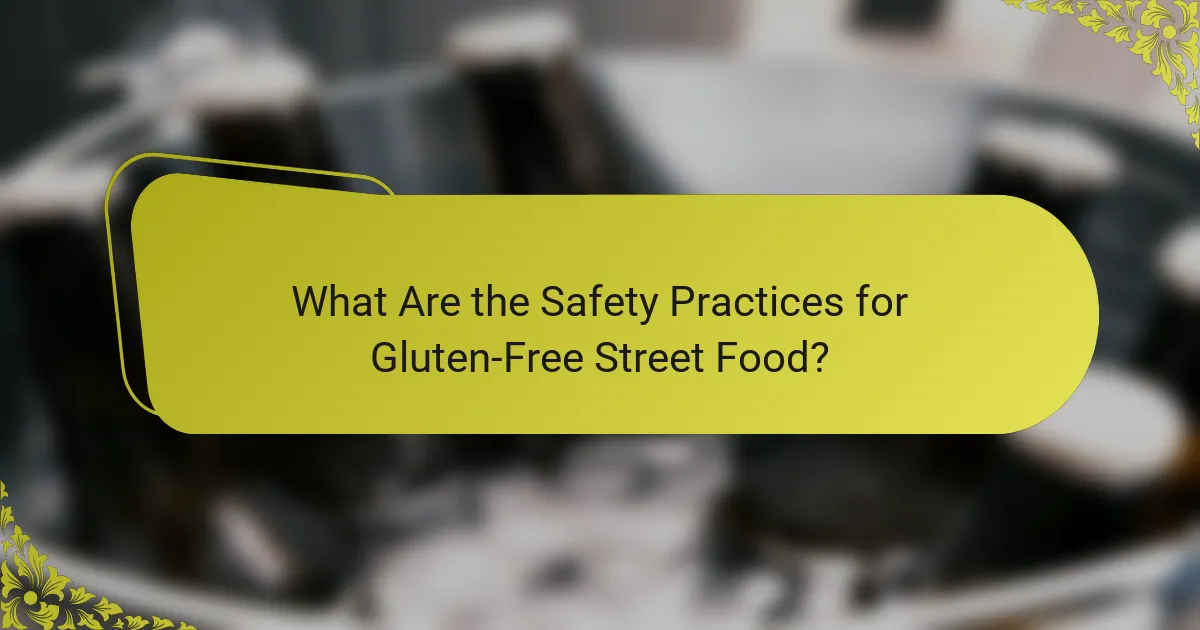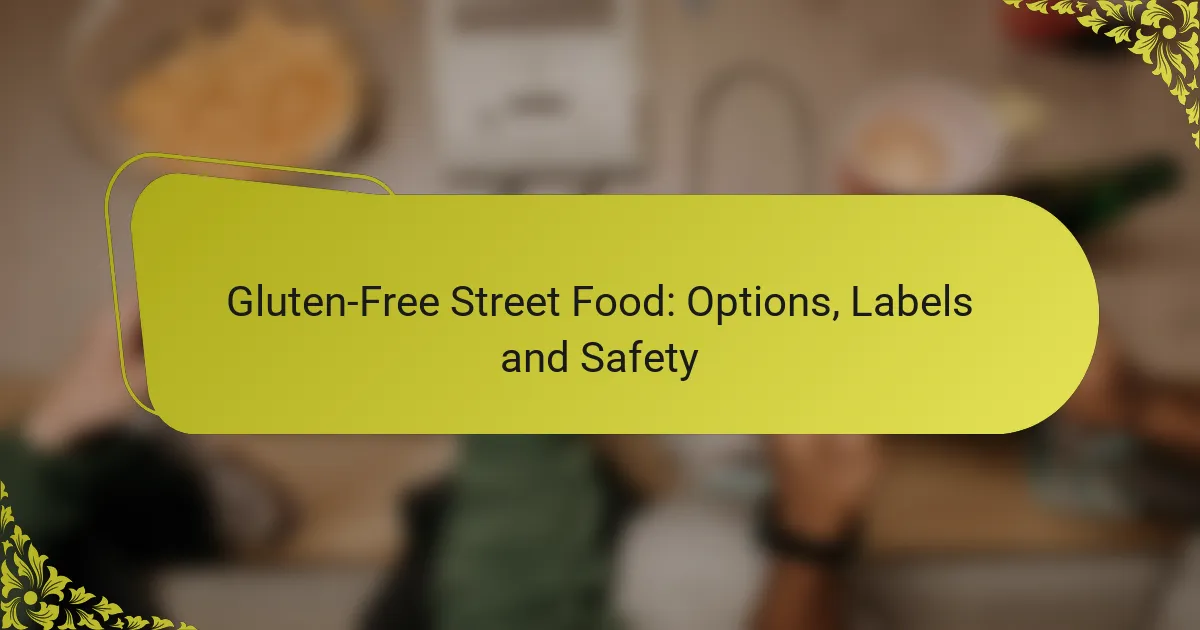For those avoiding gluten, street food can offer a delightful array of options such as tacos, rice paper rolls, and falafel wraps. To ensure a safe dining experience, it’s important to look for clear gluten-free labels and ask vendors about their preparation methods to prevent cross-contamination. By following these guidelines, you can enjoy delicious street food while maintaining your health and safety.

What Are the Best Gluten-Free Street Food Options?
Some of the best gluten-free street food options include tacos, rice paper rolls, grilled corn on the cob, falafel wraps, and gluten-free pizza. These foods are not only delicious but also widely available at various street food vendors, making them convenient choices for those avoiding gluten.
Gluten-Free Tacos
Gluten-free tacos are typically made with corn tortillas, which are naturally gluten-free. When ordering, ensure that the fillings and toppings are also free from gluten, as some sauces or marinades may contain wheat. Popular fillings include grilled meats, beans, and fresh vegetables.
To enhance flavor, look for vendors that offer fresh salsas and guacamole. Always ask about cross-contamination practices to ensure your meal is safe.
Rice Paper Rolls
Rice paper rolls are a refreshing gluten-free option filled with a variety of ingredients like shrimp, vegetables, and herbs. The rice paper wrappers are naturally gluten-free, making them a safe choice for those with gluten sensitivities. Pair them with a gluten-free dipping sauce, such as hoisin or peanut sauce, to elevate the taste.
When selecting rice paper rolls, check that the fillings do not include any gluten-containing sauces or additives. Vendors specializing in Asian cuisine often offer these rolls, making them a popular street food choice.
Grilled Corn on the Cob
Grilled corn on the cob is a simple yet flavorful gluten-free street food. Vendors often serve it with various toppings, such as butter, cheese, or spices. Ensure that any toppings used are gluten-free, as some flavored butters or seasonings may contain gluten.
This option is widely available at fairs and festivals, making it a convenient snack. It’s best enjoyed fresh off the grill for optimal taste and texture.
Falafel Wraps
Falafel wraps can be a great gluten-free street food option if made with gluten-free wraps or lettuce leaves. The falafel itself, made from ground chickpeas, is typically gluten-free, but check for any added flour in the recipe. Pairing falafel with fresh vegetables and tahini sauce adds flavor and nutrition.
When ordering, confirm that the vendor uses gluten-free wraps or offers a lettuce option to avoid gluten exposure. This dish is popular in Middle Eastern cuisine and can often be found at food trucks and stalls.
Gluten-Free Pizza
Gluten-free pizza is increasingly available at street food vendors, often made with alternative crusts like cauliflower or gluten-free flour blends. When ordering, ensure that all toppings, including sauces and cheeses, are gluten-free to avoid cross-contamination.
Look for vendors that specialize in gluten-free options, as they are more likely to have dedicated preparation areas. This option allows you to enjoy a classic favorite while adhering to gluten-free dietary needs.

How to Identify Gluten-Free Street Food?
Identifying gluten-free street food involves checking for clear labeling and understanding ingredient lists. Look for foods that are specifically marked as gluten-free and inquire about preparation methods to avoid cross-contamination.
Understanding Labels
Labels are crucial for identifying gluten-free street food. In many regions, products labeled as gluten-free must meet specific standards, often containing less than 20 parts per million (ppm) of gluten. Always look for these labels on packaging or ask vendors directly about their gluten-free offerings.
Be aware that some street food may not have formal labels, especially if prepared on-site. In such cases, asking about ingredients and preparation methods is essential to ensure safety.
Common Gluten-Free Certifications
Several certifications can help you identify gluten-free street food. Look for logos from recognized organizations, such as the Gluten-Free Certification Organization (GFCO) or the Celiac Support Association. These certifications indicate that the food has been tested and meets strict gluten-free standards.
While not all gluten-free foods will carry these certifications, they provide an added layer of assurance. Vendors who prioritize gluten-free options often display these certifications prominently.
Ingredient Lists to Check
Checking ingredient lists is vital when identifying gluten-free street food. Common gluten-containing ingredients include wheat, barley, and rye, so avoid foods that list these as components. Instead, look for alternatives like rice, corn, or quinoa.
Additionally, be cautious with sauces and dressings, as they may contain hidden gluten. Always ask for ingredient details to ensure the food is safe for those with gluten sensitivities or celiac disease.

What Are the Safety Practices for Gluten-Free Street Food?
Ensuring safety for gluten-free street food involves implementing strict measures to prevent cross-contamination, training vendors on gluten safety, and adhering to local health regulations. These practices help protect individuals with gluten sensitivities or celiac disease from harmful exposure.
Cross-Contamination Prevention
Cross-contamination occurs when gluten-free food comes into contact with gluten-containing products. To prevent this, vendors should use separate utensils, cooking surfaces, and storage areas for gluten-free items. Clear labeling and designated preparation zones can significantly reduce the risk.
Vendors should also consider using color-coded tools and equipment to easily identify gluten-free items. Regular cleaning of surfaces and equipment is essential to eliminate any residual gluten from previous food preparation.
Vendor Training on Gluten Safety
Training vendors on gluten safety is crucial for maintaining food integrity. This training should cover the importance of avoiding cross-contamination, understanding gluten sources, and recognizing symptoms of gluten exposure. Regular workshops can help keep vendors informed about best practices.
Additionally, providing vendors with resources, such as gluten-free certification programs or guidelines from reputable organizations, can enhance their knowledge and confidence in serving gluten-free options safely.
Local Health Regulations
Local health regulations often dictate how food vendors must handle gluten-free products. These regulations may include specific requirements for food preparation, labeling, and hygiene practices. Vendors should familiarize themselves with local laws to ensure compliance and maintain food safety standards.
In many regions, health departments may offer resources or training sessions to help vendors understand these regulations. Staying updated on any changes in local health codes is essential for maintaining a safe gluten-free environment for customers.

How to Choose Gluten-Free Street Food Vendors?
Choosing gluten-free street food vendors involves assessing their reputation, ingredient transparency, and equipment practices. These factors help ensure that the food is safe for those with gluten sensitivities or celiac disease.
Researching Vendor Reputation
Start by checking online reviews and social media for feedback on vendors’ gluten-free offerings. Look for comments specifically mentioning gluten-free options and customer experiences related to cross-contamination.
Local gluten-free communities or forums can also provide valuable insights. Engaging with these groups may reveal trusted vendors and those to avoid.
Asking About Ingredients
When approaching a vendor, inquire about the ingredients used in their dishes. It’s essential to ask if any sauces, seasonings, or pre-packaged items contain gluten.
Don’t hesitate to request ingredient lists or clarification on specific items. Vendors who are knowledgeable and transparent about their ingredients are more likely to prioritize gluten-free safety.
Checking for Dedicated Gluten-Free Equipment
Ensure that the vendor uses dedicated equipment for gluten-free food preparation. This includes separate frying oils, utensils, and cooking surfaces to minimize cross-contact.
If a vendor cannot confirm the use of dedicated equipment, consider it a red flag. Vendors who take gluten-free seriously will often have clear protocols in place to protect their customers.

What Are the Popular Gluten-Free Street Food Brands?
Several popular brands offer gluten-free street food options, catering to those with gluten sensitivities or celiac disease. These brands prioritize safe ingredients and clear labeling to ensure customers can enjoy their meals without worry.
Gluten-Free Gourmet
Gluten-Free Gourmet specializes in creating delicious street food that is entirely gluten-free. Their menu includes items like gourmet sandwiches, wraps, and snacks made with gluten-free grains and flours.
When choosing from Gluten-Free Gourmet, look for their clearly marked gluten-free options. They often use local ingredients, which can enhance flavor and support the community.
Sweetgreen
Sweetgreen is known for its fresh, healthy bowls and salads, many of which are gluten-free. They provide a variety of options that allow customers to customize their meals while ensuring gluten-free ingredients are available.
To enjoy a gluten-free meal at Sweetgreen, opt for their base of greens or grains that are labeled gluten-free. Always confirm with staff about cross-contamination practices, especially if you have severe allergies.
Chipotle
Chipotle offers a range of gluten-free options, including burrito bowls and salads. Their ingredients are generally fresh and can be customized to suit gluten-free diets.
When ordering at Chipotle, choose corn tortillas or skip the tortillas altogether for a gluten-free meal. Be aware of cross-contact with gluten-containing items, and inform staff of your dietary needs to ensure your meal is prepared safely.
